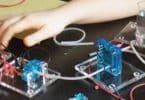Ray Optics Questions and Answers:
A neon sign does not produce
(a) Line spectrum
(b) An emission spectrum
(c) An absorption spectrum
(d) Photons
A symmetric double convex lens is cut in two equal parts by a plane perpendicular to the principal axis. If the power of the original lens was 4 D, the power of a cut lens would be
(a) 2 D
(b) 3 D
(c) 4 D
(d) 5 D
If the refractive index of red, violet and yellow lights are 1.42, 1.62 and 1.50 respectively for a medium. Its dispersive power will be
(a) 0.4
(b) 0.3
(c) 0.2
(d) 0.1
Chromatic aberration of the lens can be corrected by
(a) Reducing its aperture
(b) Proper polishing of its two surfaces
(c) Suitably combining it with another lens
(d) Providing different suitable curvature to its two surfaces
When a plane mirror is placed horizontally on level ground at a distance of 60 m from the foot of a tower, the top of the tower and its image in the mirror subtend an angle of 90o at the eye. The height of the tower will be
(a) 30 m
(b) 60 m
(c) 90 m
(d) 120 m
The color of the sky is blue due to
(a) Scattering of light
(b) Total internal reflection
(c) Total emission
The critical angle for diamond (refractive index = 2) is
(a) About 20°
(b) 60°
(c) 45°
(d) 30°
Related: Stoichiometry (Chemistry) Problems/ Answers
Under minimum deviation conditions in a prism, if a ray is incident at an angle 30o, the angle between the emergent ray and the second refracting surface of the prism is
(a) 0°
(b) 30°
(c) 45°
(d) 60°
A converging lens is used to form an image on a screen. When the upper half of the lens is covered by an opaque screen
(a) Half the image will disappear
(b) A complete image will be formed of the same intensity.
(c) Half the image will be formed of the same intensity.
(d) Complete image will be formed of decreased intensity
A convex lens, a glass slab, a glass prism and a solid sphere are all made of the same glass, the dispersive power will be
(a) In the glass slab and prism
(b) Only in prism
(c) In the lens and solid sphere
(d) In all the four
The light gathering power of a camera lens depends on
(a) Its diameter only
(b) Ratio of focal length and diameter
(c) Product of focal length and diameter
(d) Wavelength of light used
The radius of curvature of the convex surface of a thin plano-convex lens is 15 cm and the refractive index of its material is 1.6. The power of the lens will be
(a) +1 D
(b) –2D
(c) +3 D
(d) +4 D
Related: quiz on Connective tissue
A thin equiconvex lens is made of glass with refractive index 1.5 and its focal length is 0.2 m, if it acts as a concave lens of 0.5 m focal length when dipped in a liquid, the refractive index of the liquid is
(a) 17/8
(b) 15/8
(c) 13/8
(d) 9/8
The dispersive power of glasses of lenses used in an achromatic pair is in the ratio 5 : 3. If the focal length of the concave lens is 15 cm, then the nature and focal length of the other lens would be
(a) Convex, 9 cm
(b) Concave, 9 cm
(c) Convex, 25 cm
(d) Concave, 25 cm
A motor car is fitted with a convex driving mirror of focal length 20 cm. A second motor car 2.1 m board and 1.05 m high is 4 m behind the first car. What is the size of the image of the second car as seen in the mirror of the first?
(a) Breadth = 8 cm, height = 4 cm
(b) Breadth = 10 cm, height = 5 cm
(c) Breadth = 12 cm, height = 6 cm
(d) Breadth = 14 cm, height = 7 cm
Amount of light entering into the camera depends upon
(a) Focal length of the objective lens
(b) Product of focal length and diameter of the objective lens
(c) Distance of the object from camera
(d) Aperture setting of the camera
An object has an image thrice of its original size when kept at 8 cm and 16 cm from a convex lens. The focal length of the lens is
(a) 8 cm
(b) 16 cm
(c) Between 8 cm and 16 cm
(d) Less than 8 cm
Related: Permutation / Combination (Maths) Sample Paper
An imaginary line joining the optical center of the eye lens and the yellow point is called as
(a) Principal axis
(b) Vision axis
(c) Neutral axis
(d) Optical axis
A convex lens is dipped in a liquid whose refractive index is equal to the refractive index of the lens. Then its focal length will
(a) Become infinite
(b) Become small, but non–zero
(c) Remain unchanged
(d) Become zero
Image formed on the retina is
(a) Real and inverted
(b) Virtual and erect
(c) Real and erect
(d) Virtual and inverted
An object is placed at a distance 20 cm from the pole of a convex mirror of focal length 20 cm. The image is produced at :
(a) 13.3 cm
(b) 20 cm
(c) 25 cm
(d) 10 cm
In order to obtain a real image of magnification 2 using a converging lens of focal length 20 cm, where should an object be placed
(a) 50 cm
(b) 30 cm
(c) – 50 cm
(d) – 30 cm
Related: questions on Hybridization
Which mirror has a very wide field of _
(a) Concave
(b) Convex
(c) Plane
Which source is associated with a line emission spectrum?
(a) Electric fire
(b) Neon street sign
(c) Red traffic light
(d) Sun
The impact of an image on the retina remains for
(a) 0.1 sec
(b) 0.5 sec
(c) 10 sec
(d) 15 sec
What is the ray that comes back from the surface after a reaction called?
(a) Incident ray
(b) Refracted ray
(c) Reflected ray
(d) Diffused ray
The number of wavelengths in the visible spectrum
(a) 4000
(b) 6000
(c) 2000
(d) Infinite
Related: Wave optics questions
The fine powder of a colored glass is seen as
(a) Colored
(b) White
(c) That of the glass color
(d) Black
To remove myopia (short sightedness) a lens of power 0.66 D is required. The distant point of the eye is approximately
(a) 100 cm
(b) 150 cm
(c) 50 cm
(d) 25 cm
For a normal eye, the least distance of distinct vision is
(a) 0.25 m
(b) 0.50 m
(c) 25 m
(d) Infinite
An eye specialist prescribes spectacles having a combination of convex lens of focal length 40 cm in contact with a concave lens of focal length 25 cm. The power of this lens combination in diopters is
(a) + 1.5
(b) – 1.5
(c) + 6.67
(d) – 6.67
Related: questions on Hydrogen and its compounds
The plano-convex lenses of focal lengths 20 cm and 30 cm are placed together to form a double convex lens. The final focal length will be :
(a) 12 cm
(b) 60 cm
(c) 20 cm
(d) 30 cm
Two parallel pillars are 11 km away from the observer. The minimum distance between the pillars so that they can be seen separately will be
(a) 3.2 m
(b) 20.8 m
(c) 91.5 m
(d) 183 m
The line spectrum was, first of all, theoretically explained by
(a) Swan
(b) Fraunhofer
(c) Kirchoff
(d) Bohr
When objects at different distances are seen by the eye, which of the following remains constant
(a) The focal length of the eye lens
(b) The object distance from the eye lens
(c) The radii of curvature of the eye lens
(d) The image distance from the eye lens
Line spectrum contains information about
(a) The atoms of the prism
(b) The atoms of the source
(c) The molecules of the source
(d) The atoms as well as molecules of the source
Related: Sets and Relations (Mathematics) Sample paper
A man suffering from myopia can read a book placed at 10 cm distance. For reading the book at a distance of 60 cm with relaxed vision, the focal length of the lens required will be
(a) 45 cm
(b) – 20 cm
(c) – 12 cm
(d) 30 cm
A compound microscope has two lenses. The magnifying power of one is 5 and the combined magnifying power is 100. The magnifying power of the other lens is
(a) 10
(b) 20
(c) 50
(d) 25
Substance on the choroid is
(a) Japan black
(b) Nigrim pigment
(c) Carbon black
(d) Platinum black
Related: Surface Area Volume Geometry Quiz
A man can see clearly up to 3 metres. Prescribe a lens for his spectacles so that he can see clearly up to 12 metres
(a) – 3/4 D
(b) 3 D
(c) – 1/4 D
(d) – 4 D






